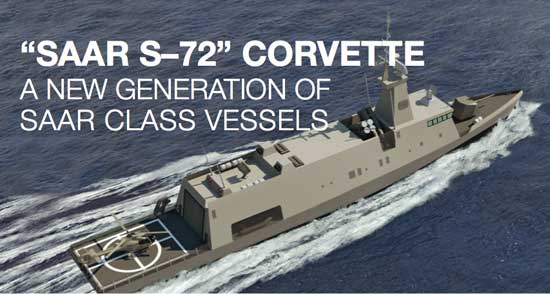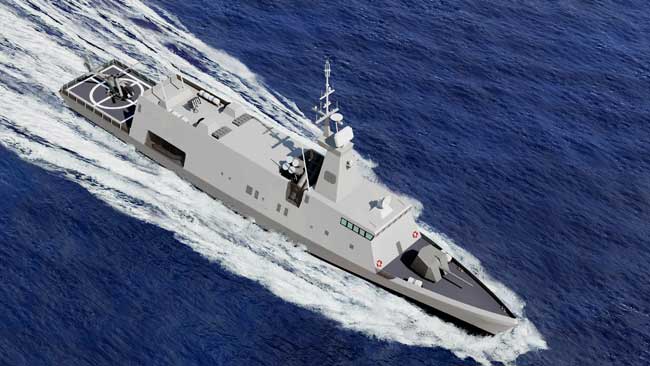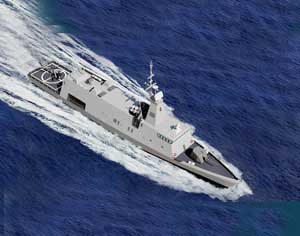
Israel Shipyards is expanding the SAAR class of missile boats, extending the range from missile boats into ‘Mini Corvette’ class vessels. The new class is addressing the growing requirements of Israel and other nations in extending maritime control and sovereignty far from their territorial waters. Defense-Update reports from IMDEX 2013.

The Israel Navy is required to expand the security and responsibility over much larger area while doing that with an ageing fleet of Saar 4, 4.5 missile boats and 5 corvettes. If only to maintain the numbers of boats in service, the Israel Navy will require several new vessels in the coming years. Many of these vessels are becoming obsolete – some of the oldest missile boats in service – INS Atzmaut (Independence) and INS Nitzahon (Victory) are reaching 35 years in service – an age considered the end of service life for such boats. Therefore, new platforms will be required in the near future. Through the years the Navy acquired 20 Saar 4/4.5 vessels, but the cash-strapped service could not afford to buy larger vessels, and, therefore limited the procurement of the larger Saar 5 corvettes to the three vessels built in the U.S. funded by Washington’s Foreign Military Sales (FMS).
[nonmember]A more detailed version of this article is available for members – Join now![/nonmember][ismember]Through the past decade the Israel Navy tried exploring every way to acquire new surface vessels or somehow renew its Saar V platforms. The only solution on the table being the Littoral Combat Ship, that Israel considered to acquire from the US through Foreign Military Sale (FMS) – much larger than what Israel requires. At the time the US asked over $400 million per ship, the Germans and Koreans were happy to offer the vessel for much less; Israel Shipyard is hopeful that four vessels could be delivered and equipped for the price of a single LCS.
Despite the clear need, the Navy still looks outside for a solution, hoping to get such vessels with German funding or as buyback from South Korea, under an offset plan. The Ministry of Defense has not set aside funding for the plan, which is expected to cost about US$850 million extending the security ring to cover the new oil and gas exploration areas offshore. The package set by the Navy planners includes four OPVs, two unmanned patrol aircraft, unmanned boats, radars and other equipment. But that money is not available yet, none has been set aside by the MOD, nor by the Navy, despite the verbal support the Navy received during the recent discussions prior to the next four-year plan. In fact, under the new government budget cut, with the Yaalon as the new Defense Minister (as the Chief of Staff prior to the 2006 Lebanon war he was responsible for unprecedented cuts that severely weakened the Israel Defense Forces), it is therefore unlikely that money will be added to the IDF or Israel Navy in the coming years.
One of the opportunities the Navy and MOD are hoping for is raising the $850 million funding by the private companies as part of the investments in developing the infrastructure for the new offshore Oil and Gas fields found about 100 miles west of the Israeli coast. The Israeli Navy hasn’t operated regularly at this distance; moreover, tightening control and beefing up securing in this area requires significant investments in aerial, surface and sub-surface assets, in addition to point-defenses of the drilling rigs themselves. Private sector has already awarded initial contracts for the protection of rigs, but is expecting that the government will share the burden of securing the sea around these rigs for safe operation. [/ismember]
The new Saar S-72 unveiled by Israel Shipyard at the recent IMDEX event in Singapore fits between the Navy’s existing Saar 4.5 missile boats, and Saar 5 corvettes. Through the years Israel Shipyards have built 33 Saar 4 and 4.5 class missile boats; 20 were delivered to the Israel Navy over the years. With the new Mini Corvette the shipyard hopes to expand it’s offering to meet the evolving requirements, of the Israel Navy, as well as of international customers overseas.
For Coast Guards and non-military operations the S-72 is a new platform that better fits the category of Offshore Patrol Vessel (OPV). For naval applications the same 800-ton vessel can be finished as a versatile ‘Mini Corvette’. Both are highly applicable to asymmetric warfare at sea, providing sufficient space for command and control, accommodation for special task forces on military or counter terror missions, or supporting rapid response or rescue operations. The large hangar stores a medium size helicopter and UAVs. The adjacent 15 meter long flight deck supports medium size helicopters up to AW139 class. The vessel is configured with loading crane, storage and berth deploying rubber boats / RHIB’s or unmanned surface vessels.
[ismember]As an OPV the S-72 can be configured with a split superstructure, (separating the hangar from the bridge), thus opening a larger deck for carrying containers, supplies and equipment. The vessel’s overall length is 72 meters, with 10.25 meter beam; the design is extendable up to 85 meters, accommodating users requiring larger vessels. Draught is 2.92 meters, adapting the vessel to littoral operations. It also fits blue ocean operations as well, withstanding sea state 7-8. The Saar 72 is powered by two MTU 16V1163M94 diesels, accelerating the vessel to a maximum speed of over 30 knots. Sustained speed is 28 knots and cruising speed is 18 knots. For armament the S-72 could mount 23-30mm automatic guns mounted on stabilized pedestals such as the new Typhoon 30. At the recent IMDEX exhibition in Singapore RAFAEL unveiled a version of the Typhoon mounting eight Non-Line of Sight missiles, enabling a vessel such as the S-72 to score a direct hit at a target 25 km away. [/ismember]

In the military configuration the Saar-72 will offer a significant upgrade over the current Saar 4.5 – in performance and combat capabilities. Applied with a slanted stealth finish, recessed exhausts, and radar integrated mast, designed to host both emitters (radar, EW) and passive sensors (ESM) without interference. The vessel can accommodate the IAI Elta EL/M-2258 Advanced lightweight Phased Array (ALPHA) multi-mission naval radar, designed for blue water and littoral warfare support. This radar was selected by the Israel Navy for the upgrading of existing vessels as well as for its new combatants. The vessel can carry different weapons, including IAI’s Barak 8 type missiles, various anti-ship missiles and precision surface attack weapons. The naval configuration is also fitted with an advanced naval gun.
[ismember]The EL/M-2258 radar provides 3D long-range air surveillance and tracking, 3D medium range automatic threat alert, target classification, and gunnery control. Such radar will become an indispensable asset in providing ‘volume defense’ against anti-ship missile attacks, launched from coastal sites (in Syria or Lebanon) or from cargo vessels that could be turned by state-sponsored terrorists into attack platforms. According to IAI, the typical coverage of the ALPHA radar exceeds 25 km, tracking low-flying antiship missiles (typically, Chinese developed sea skimmers produced in Iran that were supplied to many navies, as well as to Islamic terrorist organizations Hezbollah and Hamas). The same radar detects missiles at higher altitude as far as 120 away – typically Yakhonts, operated by the Syrians. Deploying a missile corvette as a buffer facing such threats would eliminate such risk, without the need to equip each and every rig with missile defenses. [/ismember]
Saar 72 type vessels are designed with spacious accommodation to 50 crewmembers plus 20 additional accommodations for passengers or special troops. It is equipped to sail on a 21 day missions, with mission range above 3000 NM.
Sources at the Israeli shipyard said they can complete the design and construction of the lead S-72/Saar-72 ship within a period of 30 months, and produce follow-on vessels in eight months. The shipyard can build the 72m’ vessel with its current facilities, but to accommodate the 85 meter version some expansions will be necessary.

















